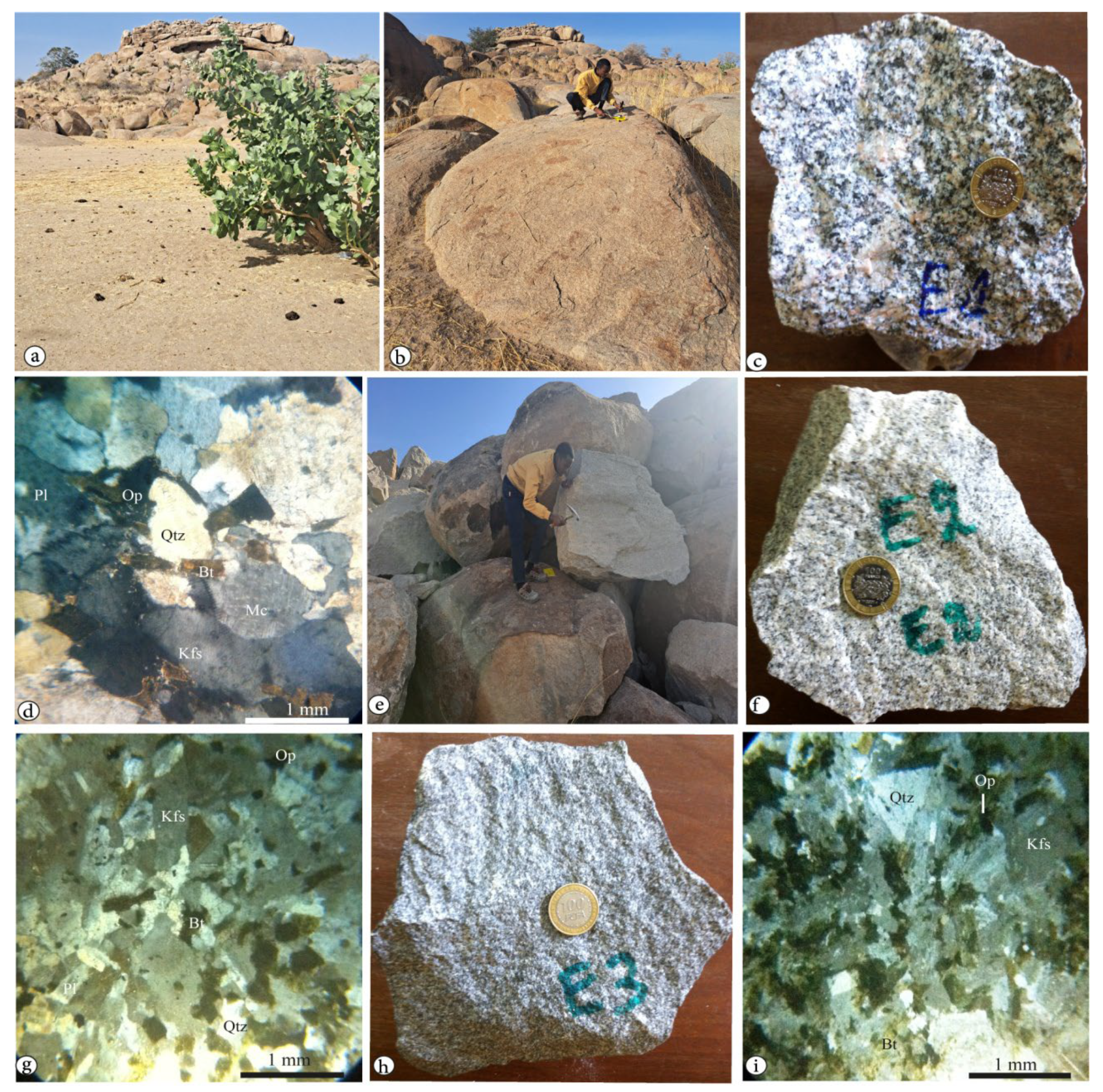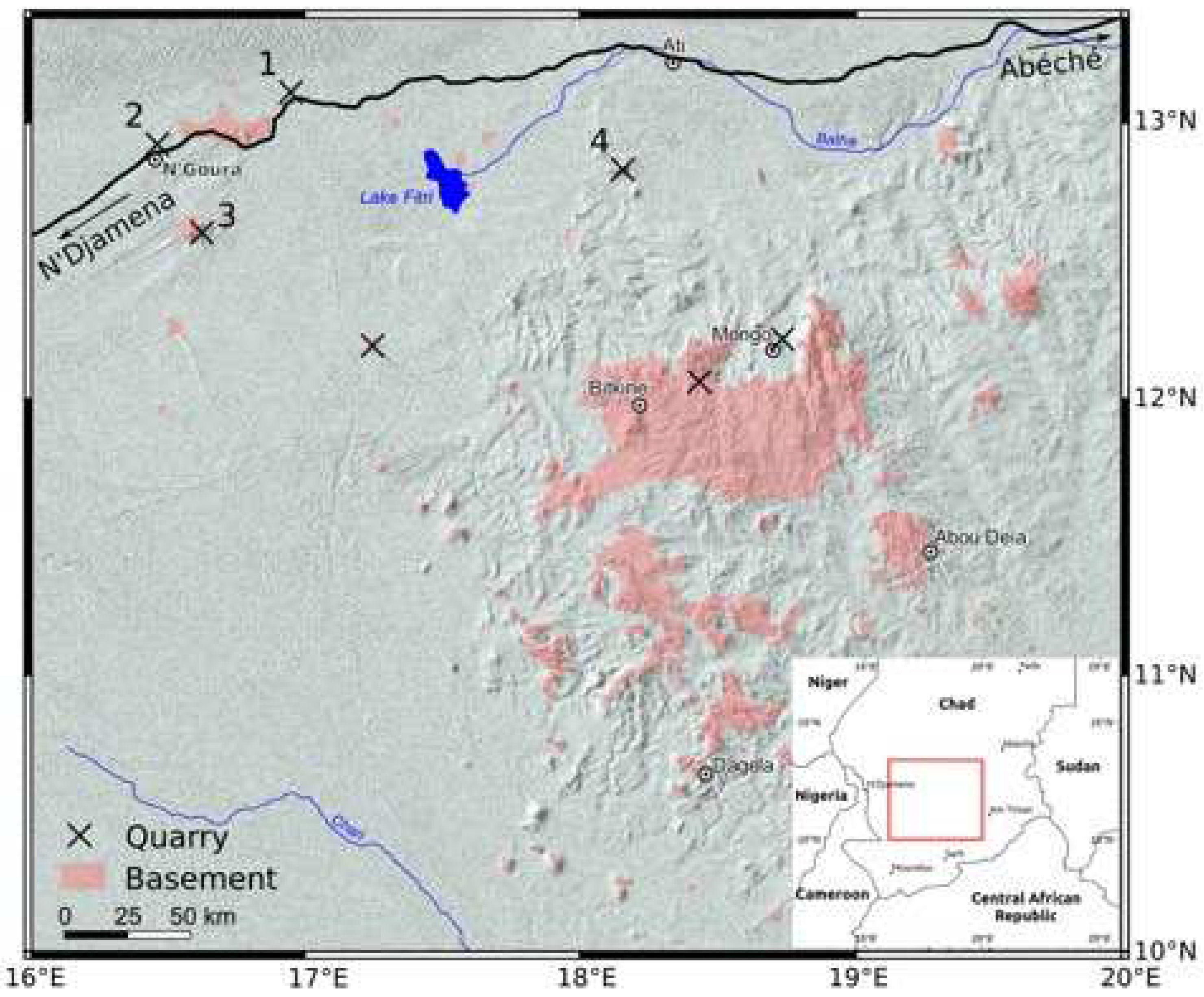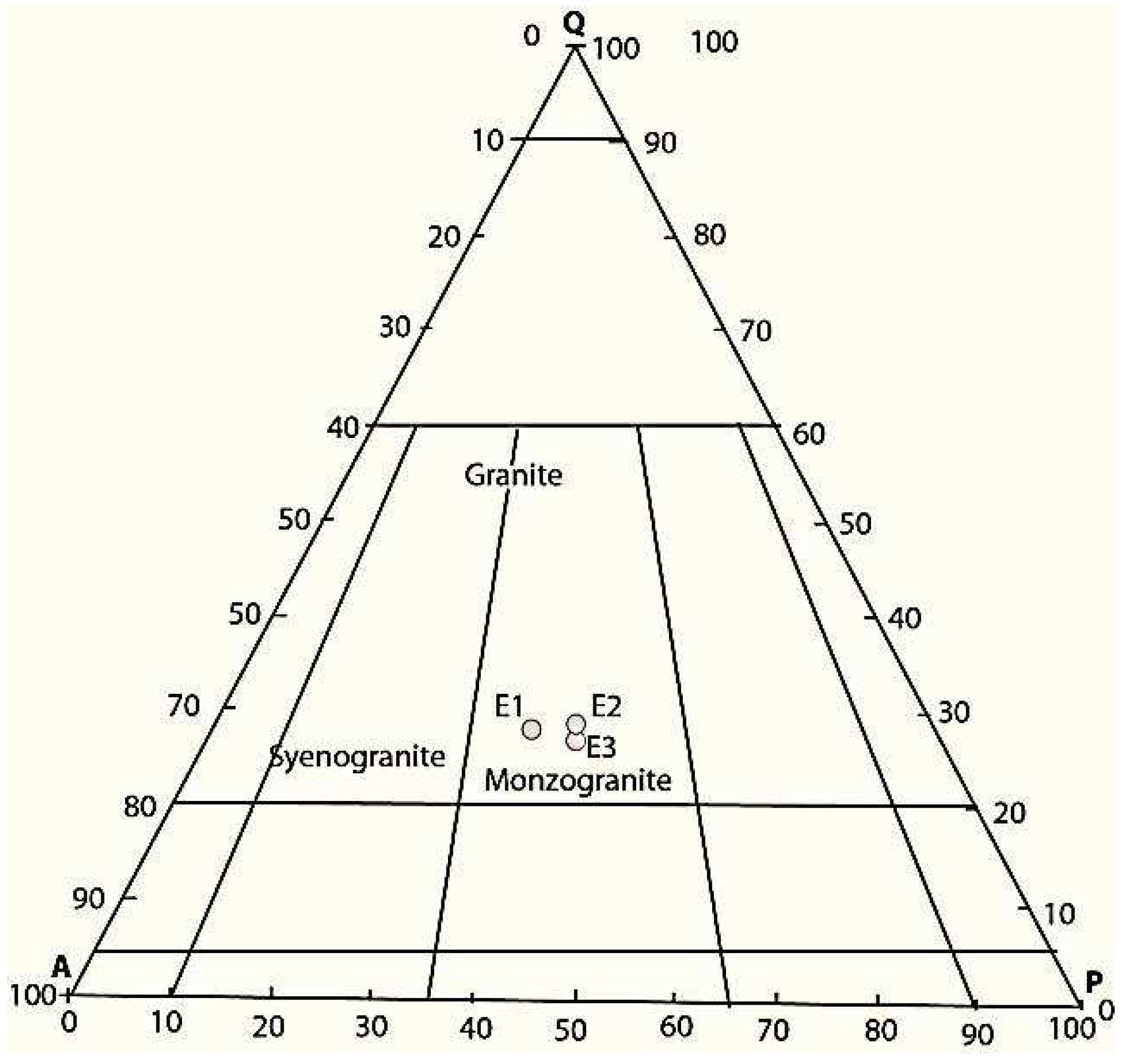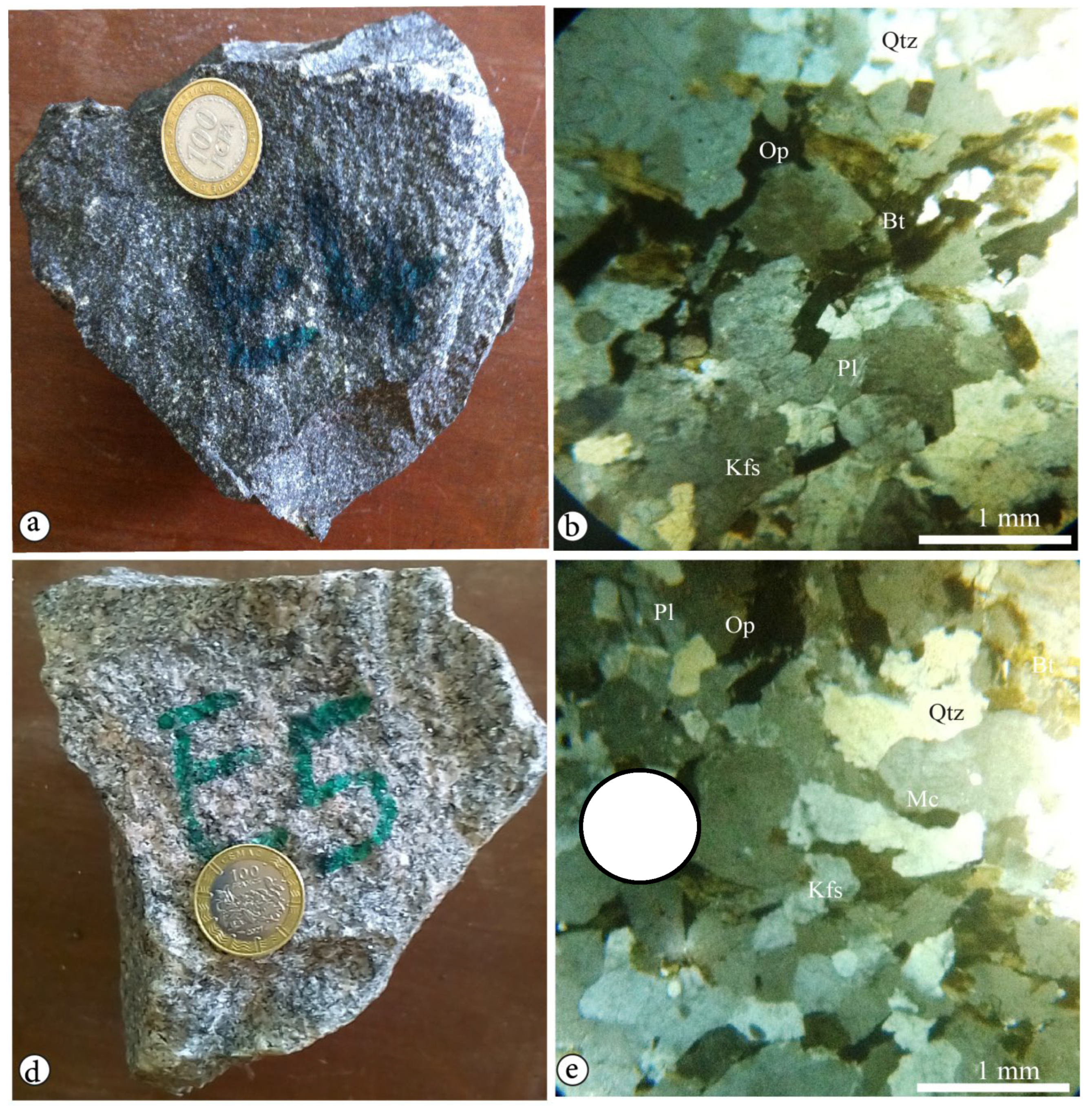1. Introduction
Natural aggregates are more or less abundant depending on the region, and their systematic use as construction materials is beginning to make them a scarce resource in some parts of Africa [
1]. According to [
2] and [
3], there are three (3) types of aggregate, namely natural aggregates from solid rock quarries and alluvial deposits (quarry and alluvial aggregates), artificial aggregates from the thermal transformation of rocks, ores and processed industrial by-products, and recycled aggregates from the transformation of inorganic materials previously used in construction. Each use must have its own specific characteristics [
4].
Central Chad (
Figure 1), is mostly an extremely flat area, characterized by an endorheic basin, once occupied by the mega-Chad lake, of one third million km
2 extension [
5]. Therefore, basement very rarely outcrops above the ubiquitous plio-quaternary fine sediments. Central Chad has very scarce resources of hard rock for quarries (
Figure 1) so the identification of proper resources for aggregates, in particular used for road construction, is needed to improve the existing un-asphalted network. Indeed, this network is characterized by near total traffic cuts in rainy season and heavy conditions the rest of the year, thus hampering economic development. The present study of aggregates in the Alfallé area was initiated with this aim in mind. A few small hard rock quarries pits have been already opened in the area, Alfallé one being nearly the northermost (
Figure 1). The nearest opened pits lay in N’Goura and Moyto (60 km to the West), and Birni (130 km to the East) massifs. To the North, no rock outcrops in the next 600 km. To the South, the Massif of Guera outcrops more largely [
6] but it lays outside the main road from the capital city to Sudan, via Abéché. To gauge the scarcity of aggregate resource in the area we can mention the fact that N’Goura and Moyto active quarries are becoming significant providers for the capital city N’Djamena, 170 km to the West. Indeed, the only quarries nearer to the capital, Hadjer el Hamis and Dandi, are approaching exhaustion.
All outcropping rocks in the area of
Figure 1 belong to the Neoproterozoic orogeny and correspond to granitoids with minor presence of more mafic intrusions as well as metamorphic rocks [
7,
8,
9]. Intrusions are dated in between 545 and 590 Ma. In particular the N’Goura and Birni massif are made of granites.
2. Methodology
After an overall survey of the study area, three petrographic facies were identified. A total of five samples were taken outside the pit, corresponding to the different petrographic types encountered. Large samples were taken so that they could be used to make thin sections for optical microscopy and prepare aggregates for geotechnical testing. The sampling map shows where the samples were taken (
Figure 2). Physical and geotechnical properties were measured on aggregates obtained by manual crushing of the materials to the granular class 10/14mm. Geotechnical tests were carried out in the Civil Engineering Laboratory in N'Djamena. The geotechnical parameters Los-Angeles (LA) and micro-Deval coefficients were determined in accordance with French norms. The LA and micro-Deval coefficients are the percentage of the initial aggregate that passes the 1.6 mm sieve after being tumbled together with steel balls in a normalized test. While the Los Angeles test is designed to produce more shock in between the gravels and steel balls, the micro-Deval test privileges wear by friction. The apparent and grain densities were determined using the weighing method.
3. Results and discussion
3.1. Petrographic study
The Massif d'Alfallé appears as an inselberg about 30 meters above a vast sandy plain (
Figure 3a). It comprises three petrographic facies: alkali feldspar megacrystalline granite, biotite microgranite and biotite gneiss. Field relationships show that the megacrystal granite is intrusive in the gneiss, while the microgranite is intrusive in the other two facies.
Feldspar megacrystal granite
Alkali feldspar megacrystalline granite (E1) outcrops in dark grey balls and blocks from the summit to the foot of the hill (
Figure 3b). In these balls and blocks, pink and sometimes milky white feldspar crystals up to 3 cm in size are scattered among the medium grains, giving the rock a gritty porphyroid texture (
Figure 3c). In thin sections, granite is composed of quartz, orthoclase, plagioclase, biotite and opaque minerals. Quartz (30%) is xenomorphic, no larger than 1.5 mm, with undulating extinction (
Figure 3d). Orthoclase (30%) is automorphic to sub-automorphic, sometimes up to 1cm in size, and alters to damourite (
Figure 3d). Plagioclase (20%) is automorphic to sub-automorphic, sometimes up to 1.5 mm in size, and is often close to quartz and orthoclase crystals. Biotite (15%) is generally in contact with quartz, plagioclase and alkali feldspar but is also sometimes included in plagioclase. Opaque minerals (≈5%).
Figure 3.
Photograph and microphotograph of the different petrographic types outcropping in the Alfallé massif: (a) general view (b) Outcrop in balls and blocks of alkaline feldspar megacrystalline granite. (c) Sample of alkali feldspar megacrystalline granite. (d) Microphotograph of alkali feldspar megacrystalline granite. (e, f, g, h, i) Boulder outcrop (e), samples (f and h) and microphotographs (g and i) of biotite microgranite.
Figure 3.
Photograph and microphotograph of the different petrographic types outcropping in the Alfallé massif: (a) general view (b) Outcrop in balls and blocks of alkaline feldspar megacrystalline granite. (c) Sample of alkali feldspar megacrystalline granite. (d) Microphotograph of alkali feldspar megacrystalline granite. (e, f, g, h, i) Boulder outcrop (e), samples (f and h) and microphotographs (g and i) of biotite microgranite.
Biotite microgranite (E2-E3)
Biotite microgranite outcrops in balls and blocks within alkali feldspar megacryst granite (
Figure 3e). It is light to dark grey (
Figure 3e,f) and has a grainy texture with medium to fine grains of quartz, orthoclase, plagioclase and biotite (
Figure 3g). Quartz (15-20%) is automorphic to sub-automorphic, sometimes up to 1mm in size (
Figure 3h). Orthoclase (20-25%) is sub-automorphic, up to 1.2 mm in size, and alters to damourite. Plagioclase (18-25%) is automorphic up to 0.75 mm in size and is often associated with quartz and orthoclase. However, some sections are as large as 1.5mm. Biotite (20-25%) occurs as small flakes in association with quartz, plagioclase and alkali feldspar. The accessory phases consist of opaque minerals and sphene. Opaque minerals (≈4%) are frequently associated with biotite, from which they are derived by alteration, but are also included in plagioclase, alkali feldspar and quartz. Sphene (trace) is diamond-shaped and generally associated with orthoclase and quartz.
The recalculated proportions of the cardinal minerals; quartz (Q), alkali feldspar (A) and plagioclase (P) from samples E1, E2 and E3 have been projected in the QAP diagram in
Figure 4. These different samples occupy the granite domain and more specifically the monzogranite domain.
Biotite gneiss (E4-E5)
The biotite gneiss outcrops in balls and blocks ranging in size from 120cm to 3.4m in diameter at the foot and on the sides of the hill. The rock has medium-sized grains and a finely foliated structure, marked by the preferential orientation of minerals organised in alternating fine bands of different colour and composition (
Figure 5a–d). The light bands, less than 1 mm thick, are rich in quartz and alkali feldspars (
Figure 5a,c). The dark bands, less than 0.5 mm thick, are made up of biotite flakes. Microscopically, the rock has a heterogranular granolepidoblastic microstructure characterised by close-packed phenoblasts (quartz, alkali feldspars and plagioclase) and biotite flakes (
Figure 5b and d). Accessory phases are represented by sphene and opaque minerals. Quartz (25-30%) is in the form of xenomorphic crystals with undulating extinction. It is very often associated with alkali feldspars and plagioclase, with which it forms the clear band. Alkali feldspars (25-27%) are represented by orthoclase and microcline. Orthoclase (20-22%) is in the form of sub-automorphic to xenomorphic crystals with blunt contours (
Figure 5b), ranging in size from 0.5 to 2mm, and in places shows undulating extinctions. The orthoclase, like the other phenoblasts (quartz, alkali feldspars and plagioclase) is molded by biotite flakes, shows signs of alteration to sericite. Microcline (≈5%) is sub-automorphic to xenomorphic and results from mechanical alteration of orthoclase. Plagioclase (17%) occurs as large sub-automorphic patches of up to 1mm (
Figure 5b). It sometimes has the polysynthetic macle of albite. Opaque minerals are sometimes found as inclusions in these plagioclases. Some sections show damourite alteration. Biotite (25-27%) appears as elongated, preferentially oriented flakes (
Figure 5b), moulding the phenocrysts. Opaque minerals (≈5%) are globular in shape as inclusions in the phenoblasts or as streaks along the edges of the biotite (
Figure 5d).
3.2. Geotechnical study
3.2.1. Physical characteristics of aggregates
The physical parameters (apparent and grain density ρ and ρ
s) make it possible to judge the quality of the constructive properties of the materials. These parameters are widely used in civil engineering because they can be determined by relatively simple, reliable and inexpensive methods. The results of these parameters are shown in
Table 1.
Table 1 shows that the aggregates studied have specific density values between 2.58 and 2.75 g/cm
3, with an average value of 2.66 g/cm
3. The bulk density is between 1.3 and 1.4 g/cm
3, with an average value of 1.3 g/cm
3.
The results obtained from the specific density are close to those obtained by [
11] which are 2.67 to 2.68g/cm
3, by [
12] which are 2.62 to 2.64g/cm
3, by [
13] which are 2. 61 to 2.68 g/cm
3, by [
14] in the Okola zone in central Cameroon which are 2.81 g/cm
3 and by [
15] which are 2.6g/cm
3 on average. The values obtained do not agree with those found by [
16] on the granites of the N'goura massif, which are between 2.38 g/cm
3 and 2.60 g/cm3, and by [
17], which are between 2.52 and 2.58 g/cm
3. This discrepancy in values is due to the petrographic nature, size and content of the minerals and the degree of fissuring.
3.2.2. Mechanical characteristics of aggregates
In addition to the possibility of judging quality, the mechanical parameters of an aggregate make it possible to determine its classification code and deduce its use. The results of the Los-Angeles and Microdeval wet tests are presented in
Table 2.
Table 2 shows that the Los Angeles coefficient in the study area varies from 11.2% to 28.9%, with an average value of 20.1%. The wet Micro Deval coefficient varies from 5.2% to 10.8%, with an average value of 7.6%.
The quality of the materials studied was assessed in accordance with European standards EN1097-1 and EN1097-2 (
Table 3).
According to EN 1097-1, sample E1(CLA=28.9%) has limited impact resistance and sample E4(CLA=11.2%) shows excellent impact resistance. Samples E2(CLA=20.7%), E3(CLA=16.9%) and E5(CLA=23%) showed satisfactory impact properties. This work is similar to the results obtained by [
12] on Ouaddaï granite with Los-Angeles coefficients of 28 to 31% and those of [
18] for a Los-Angeles coefficient of 29.5%. The values determined do not agree with those obtained by [
15] varying from 30 to 33%, by [
14] on migmatitic gneisses from the Okola zone, Central Cameroon (41-43%), by [
19] where he found Los-Angeles coefficients on classes 6.3/10 and 10/14, respectively 34.36 and 32.58% and by [
20] Mahamat Taher (2021) obtained on the Oyo massif (60.24 - 78.94%) and the Mongo massif (25.78 - 51.62%). This difference in values is due to the lithological nature of the geological formations studied.
According to standard EN 1097-2, samples E1, E2, E4 and E5, which respectively have Micro-Deval coefficients (CMDE=8.6%; CMDE=5.2%; CMDE=5.4% and CMDE=7.9%), show excellent resistance to wear, with the exception of sample E3 (CMDE=10.8%), which shows satisfactory resistance.
4. Conclusions
From a petrographic point of view, the Alfallé rocks are made up of three petrographic types: alkali feldspar megacrystal granite, biotite microgranite and biotite gneiss. The granites have micrograined and grained textures, while the gneisses have a foliated structure with a grano-lepidoblastic texture. These formations are composed of quartz, orthoclase, microcline, plagioclase, biotite and opaque minerals.
The results of the geotechnical tests showed that the aggregates studied have specific densities of between 2.58 and 2.75 g/cm3, with an average value of 2.66 g/cm3, and densities of between 1.3 and 1.4 g/cm3, with an average value of 1.3 g/cm3. The mechanical data shows that the aggregates studied have a Los-Angeles coefficient ranging from 11.2% to 28.9%, with an average value of 20.1%, and a wet Micro-Deval coefficient ranging from 5.2% to 10.8%, with an average value of 7.6%.
The mechanical characteristics of the materials studied show that impact resistance is satisfactory in most of the samples analysed, and their use does not require prior treatment, with the exception of sample E4, which shows excellent resistance. As for wear resistance, the aggregates studied show excellent resistance with the exception of sample E3 which shows satisfactory resistance. These results are conclusive for the opening of an aggregates quarry.
Author Contributions
H.Z. Al-hadj, designed the study, performed the sampling and wrote the article.; P. Rochette corrected the article and performed submission and revision; A.B. Allafouza performed some measurements and interpretations.
Funding
French Embassy in Chad.
Data Availability Statement
all data used is available in the article.
Acknowledgments
This paper was writen during a stay of first author in Aix en Provence, funded by the French Embassy in N’Djamena, Chad, for which we are particularly grateful. Y. Quesnel is thanked for designing Figure 1.
Conflicts of Interest
The authors declare no conflict of interest.
References
- Vouffo, M. Caractérisation des granulats de la region de l’Ouest-Cameroun en vue de leur meilleure utilisation dans les travaux de genie civil: application aux matériaux pyroclastiques de Bafoussam I. Ph.D. Thesis, Dschang University, Cameroon, 2022; 216p.
- Zitouni, S. Effet de la granulométrie (grosseur et fraction granulaire) des granulats concassés sur les Caractéristiques du béton, Thesis, University of Mohamed Boudiaf-M’Sila, Algeria, 2016, 176p.
- Liouraci, W.; Zeroual, Y. Les granulats de la carrière d’El Milia, pétrographie des roches, Caractéristiques géométriques et géomécaniques des produits dérivés. Engineering thesis, University of Jijel, Algeria, 2012, 114p.
- Toubou, T.D.R. Caractérisation physico-mécanique des granulats des carrières de Sancho et bamougoum en vue de la formulation d’un béton b25 : application au projet de construction du stade municipal de Bafang. Master’s Thesis, Dschang University, Cameroon, 2020; 54p. [Google Scholar]
- Schuster, M., Roquin, C., Duringer, P., Brunet, M., Caugy, M., Fontugne, M., ... & Ghienne, J. F. (2005). Holocene lake Mega-Chad palaeoshorelines from space. Quaternary Science Reviews, 24(16-17), 1821-1827.
- Mbaihoudou,D.; Jean, C. D.; Maurice, K.; Zagalo, A. H.; Armand,K.D.; Julios, E. A.; Jules, T. K. Petrogenesis of Magnesian High-K Granitoids From Bitkine (Centre Chad Massif): Major and Trace Elements Constraints. European Journal of Environment and Earth Sciences,2020, 1(5),1-6.
- De Wit, M.J.; Bowring, S.; Buchwald, R.; Dudas, F.Ö.; MacPhee, D.; Tagne-Kamga, G.; Dunn, N.; Salet, A.M.; Nambatingar, D. Geochemical reconnaissance of the Guéra and Ouaddaï Massifs in Chad: evolution of Proterozoic crust in the Central Sahara Shield. South African Journal of Geology, 124, 2021, 353-382.
- Shellnutt, J.G.; Yeh, M.-W.; Lee, T.-Y.; Iizuka, Y.; Pham, N.H.T.; Yang, C.-C. The origin of late ediacaran post-collisional granites near the Chad lineament, saharan metacraton, south-Central Chad. Lithos 304–307, 2018, 450–467. [CrossRef]
- Shellnutt, J.G.; Pham, N.H.T.; Yeh, M.W.; Lee, T.Y. Two series of Ediacaran collision-related granites in the Guéra Massif, SouthCentral Chad: Tectono-magmatic constraints on the terminal collision of the eastern Central African Orogenic Belt. Precambrian Res. 2020, 347, 105823. [Google Scholar] [CrossRef]
- Streickeisen A.L. Classification of the common igneous rocks by means of their chemical composition: a provisional attempt. Neuesjahrbuch fur MineralogieMonatshefte, 1976, 1,1-15p.
- Manseur, N. ; Ziani, S. Etude et caractérisation des granulats recyclés de démolition. Mémoire de Master en Mines. Université Abderahmane Mira-Bejaia, 2014,135p.
- Al-hadj,H.Z. Caractérisation géotechnique des granites de la région du Ouaddaï en vue de leur utilisation en génie civil. Master’s Thesis, Dschang University, Cameroon, 2014; 72p.
- Houga, A.; Soltana, A. Contribution à la valorisation des potentiels locaux en granulats de la région d’Ouargla par les méthodes géotechniques. Engineering Thesis, University of Kasdi Merbah Ouargla, Algeria, 2014; 56p. [Google Scholar]
- Bekon, N. Caractérisation Géotechnique et Mécanique des Produits D’altération des Gneiss Migmatiques de la Zone d’Okola (Centre Cameroun). Master’s Thesis, Yaoundé University, Yaoundé, Cameroon, 2012; 73p. [Google Scholar]
- Abdallah, A. A. Caractérisation pétrographique et géotechnique des granites de Hadjer Médego (Batha) en vue de leur utilisation en génie civil. Master’s Thesis, University of N’Djamena, Chad, 2022; 70p. [Google Scholar]
- Allaramadji, D. Caractérisation pétrographique et géotechnique des granites du massif de N’Goura (Centre Sud/Tchad) en vue de leur utilisation en génie civil. Master’s Thesis, Dschang University, Cameroon, 2021; 64p. [Google Scholar]
- Mahamat, T.A.D. Caractérisation géologique et géotechnique des granites de Mongo (Guera, Tchad). Master’s Thesis, University of Yaoundé I, Cameroon, 2021; 64p. [Google Scholar]
- Boutrika, R. B. S.; Mazouzi, A.; Gherbi, B.; Kahlaoui, T. Etude pétrographique et géotechnique du massif granitique d’Intounine (Tamarasset-Hoggar Central). 3ème Colloque International sur la Géologie du Sahara, Algeria, 2016, 5p.
- Tebah, A. Caractérisation des granulats de la carrière de Leboudi en vue de leur utilisation dans le génie civil. Professional Master's Thesis, Dschang University, Cameroon, 2018; 61p. [Google Scholar]
- Al-hadj, H. Z.; Rochette, P.; Mahamat, T.A. D. Petrography and Geotechnical Characteristics of Aggregates from the Oyo and Mongo Massifs (Chad): Implications for the Construction of Structures. Geosciences MDPI, 2022, 12 (301), 1-10.
|
Disclaimer/Publisher’s Note: The statements, opinions and data contained in all publications are solely those of the individual author(s) and contributor(s) and not of MDPI and/or the editor(s). MDPI and/or the editor(s) disclaim responsibility for any injury to people or property resulting from any ideas, methods, instructions or products referred to in the content. |
© 2023 by the authors. Licensee MDPI, Basel, Switzerland. This article is an open access article distributed under the terms and conditions of the Creative Commons Attribution (CC BY) license (http://creativecommons.org/licenses/by/4.0/).










